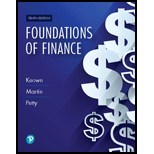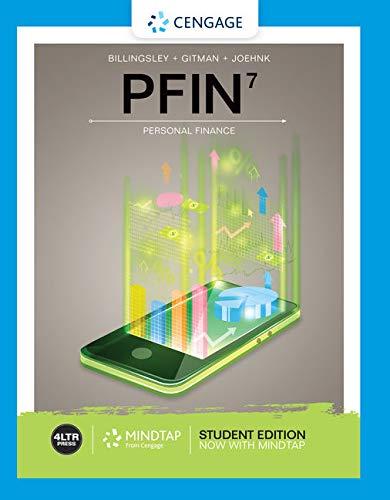
Pearson eText Foundations of Finance -- Instant Access (Pearson+)
10th Edition
ISBN: 9780135639382
Author: Arthur Keown, John Martin
Publisher: PEARSON+
expand_more
expand_more
format_list_bulleted
Question
Chapter 5, Problem 26SP
Summary Introduction
To determine: The
Expert Solution & Answer
Want to see the full answer?
Check out a sample textbook solution
Students have asked these similar questions
Please help me with this , with tge store name puebleo in St. Thomas US virgin islands
I would like to expand pueblo in S5. Thomas virgin islands to Spain. Please help with an analysis expansion.
Please help me with this, guidelines for the super market pueblo in St. Thomas US virgin islands
Chapter 5 Solutions
Pearson eText Foundations of Finance -- Instant Access (Pearson+)
Ch. 5 - Prob. 1RQCh. 5 - The processes of discounting and compounding are...Ch. 5 - Prob. 3RQCh. 5 - Prob. 4RQCh. 5 - Prob. 5RQCh. 5 - Prob. 1SPCh. 5 - Prob. 2SPCh. 5 - Prob. 3SPCh. 5 - Prob. 4SPCh. 5 - Prob. 5SP
Ch. 5 - (Compound value) Stanford Simmons, who recently...Ch. 5 - (Future value) Sarah Wiggum would like to make a...Ch. 5 - Prob. 8SPCh. 5 - (Future value) Giancarlo Stanton hit 59 home runs...Ch. 5 - Prob. 10SPCh. 5 - Prob. 11SPCh. 5 - Prob. 12SPCh. 5 - Prob. 13SPCh. 5 - Prob. 14SPCh. 5 - Prob. 15SPCh. 5 - Prob. 16SPCh. 5 - Prob. 17SPCh. 5 - Prob. 18SPCh. 5 - Prob. 19SPCh. 5 - Prob. 20SPCh. 5 - Prob. 21SPCh. 5 - Prob. 22SPCh. 5 - Prob. 23SPCh. 5 - Prob. 24SPCh. 5 - (Solving for PMT of an annuity) To pay for your...Ch. 5 - Prob. 26SPCh. 5 - Prob. 27SPCh. 5 - (Loan amortization) On December 31, Beth Klemkosky...Ch. 5 - (Solving for r of an annuity) You lend a friend...Ch. 5 - Prob. 30SPCh. 5 - (Compound annuity) You plan on buying some...Ch. 5 - (Loan amortization) On December 31, Son-Nan Chen...Ch. 5 - (Loan amortization) To buy a new house you must...Ch. 5 - Prob. 34SPCh. 5 - Prob. 35SPCh. 5 - Prob. 36SPCh. 5 - Prob. 37SPCh. 5 - Prob. 38SPCh. 5 - (Compound interest uith nonannnal periods) a....Ch. 5 - (Compound interest with nonannual periods) After...Ch. 5 - Prob. 41SPCh. 5 - (Spreadsheet problem) To buy a new house you take...Ch. 5 - (Nonannual compounding using a calculator) Jesse...Ch. 5 - (Nonannual compounding using a calculator)...Ch. 5 - (Nonannual compounding using a calculator) Fords...Ch. 5 - Prob. 46SPCh. 5 - (Nonannual compounding using a calculator) Dennis...Ch. 5 - Prob. 48SPCh. 5 - (Calculating the effective annual rate) Youve just...Ch. 5 - Prob. 50SPCh. 5 - Prob. 51SPCh. 5 - (Present value) The Kumar Corporation is planning...Ch. 5 - (Perpetuities) What is the present value of the...Ch. 5 - (Complex present value) How much do you have to...Ch. 5 - (Complex present value) You would like to have...Ch. 5 - Prob. 56SPCh. 5 - Prob. 57SPCh. 5 - Prob. 58SPCh. 5 - Prob. 59SPCh. 5 - (Present value of a complex stream) Don Draper has...Ch. 5 - (Present value of a complex stream) Don Draper has...Ch. 5 - (Complex stream of cash flows) Roger Sterling has...Ch. 5 - (Future and present value using a calculator) In...Ch. 5 - Prob. 1MCCh. 5 - Prob. 2MCCh. 5 - Prob. 3MCCh. 5 - Prob. 4MCCh. 5 - Prob. 5MCCh. 5 - Prob. 6MCCh. 5 - Prob. 7MCCh. 5 - Prob. 8MCCh. 5 - Prob. 9MCCh. 5 - Prob. 10MCCh. 5 - Prob. 11MC
Knowledge Booster
Similar questions
- Need the below table filled out for Short-term debt %, Long-term debt $,%, Common equity $,% and Total capital $,%. Market Value Capital Structure Suppose the Schoof Company has this book value balance sheet: Current assets $30,000,000 Current liabilities $20,000,000 Notes payable 10,000,000 Fixed assets 70,000,000 Long-term debt 30,000,000 Common stock (1 million shares) 1,000,000 Retained earnings 39,000,000 Total assets $100,000,000 Total liabilities and equity $100,000,000 The notes payable are to banks, and the interest rate on this debt is 11%, the same as the rate on new bank loans. These bank loans are not used for seasonal financing but instead are part of the company's permanent capital structure. The long-term debt consists of 30,000 bonds, each with a par value of $1,000, an annual coupon interest rate of 6%, and a 15-year maturity. The going rate of interest on new long-term debt, rd, is 12%, and this is the…arrow_forwardNed assistance with Q3 and Q4 below? Cost of Equity The earnings, dividends, and stock price of Shelby Inc. are expected to grow at 6% per year in the future. Shelby's common stock sells for $21 per share, its last dividend was $1.00, and the company will pay a dividend of $1.06 at the end of the current year. Using the discounted cash flow approach, what is its cost of equity? Round your answer to two decimal places. 11.06 % If the firm's beta is 1.3, the risk-free rate is 8%, and the expected return on the market is 11%, then what would be the firm's cost of equity based on the CAPM approach? Round your answer to two decimal places. 11.90% If the firm's bonds earn a return of 9%, then what would be your estimate of rs using the own-bond-yield-plus-judgmental-risk-premium approach? (Hint: Use the mid-point of the risk premium range.) Round your answer to two decimal places. % On the basis of the results of parts a–c, what would be your estimate of Shelby's cost of equity?…arrow_forwardWhat monthly compounded interest rate would Second National Bank need to pay on savings deposits to provide an effective rate of 6.2%?arrow_forward
- Hello tutor this is himlton biotech problem.arrow_forwardYan Yan Corp. has a $2,000 par value bond outstanding with a coupon rate of 4.7 percent paid semiannually and 13 years to maturity. The yield to maturity of the bond is 5.05 percent. What is the dollar price of the bond?arrow_forwardA trip goa quesarrow_forward
arrow_back_ios
SEE MORE QUESTIONS
arrow_forward_ios
Recommended textbooks for you
 EBK CONTEMPORARY FINANCIAL MANAGEMENTFinanceISBN:9781337514835Author:MOYERPublisher:CENGAGE LEARNING - CONSIGNMENT
EBK CONTEMPORARY FINANCIAL MANAGEMENTFinanceISBN:9781337514835Author:MOYERPublisher:CENGAGE LEARNING - CONSIGNMENT Pfin (with Mindtap, 1 Term Printed Access Card) (...FinanceISBN:9780357033609Author:Randall Billingsley, Lawrence J. Gitman, Michael D. JoehnkPublisher:Cengage Learning
Pfin (with Mindtap, 1 Term Printed Access Card) (...FinanceISBN:9780357033609Author:Randall Billingsley, Lawrence J. Gitman, Michael D. JoehnkPublisher:Cengage Learning

EBK CONTEMPORARY FINANCIAL MANAGEMENT
Finance
ISBN:9781337514835
Author:MOYER
Publisher:CENGAGE LEARNING - CONSIGNMENT

Pfin (with Mindtap, 1 Term Printed Access Card) (...
Finance
ISBN:9780357033609
Author:Randall Billingsley, Lawrence J. Gitman, Michael D. Joehnk
Publisher:Cengage Learning
